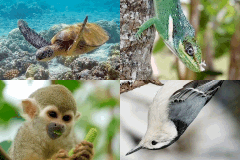AnAge entry for Capreolus capreolus
Classification (HAGRID: 01671)
- Taxonomy
-
Kingdom: Animalia
Phylum: Chordata
Class: Mammalia (Taxon entry)
Order: Artiodactyla
Family: Cervidae (Taxon entry)
Genus: Capreolus
- Species
- Capreolus capreolus
- Common name
- Western roe deer
Lifespan, ageing, and relevant traits
- Maximum longevity
- 17.5 years (captivity)
- Source
- ref. 671
- Sample size
- Medium
- Data quality
- Acceptable
- Observations
Young females have an over 90% survival in the wild, though an increased mortality with age has been reported for both males and females after about 8 years of age [0800]. These animals may live up to 15 years in the wild [0542]. One wild born female was about 17.5 years when she died in captivity [0671]. Haematological parameters have been shown to exhibit senescence in the wild, which differ between sex and populations [1206]. The implantation can be delayed from 2 to 5.5 months, so the total gestation time can last from 122 to 305 days.
Life history traits (averages)
- No information is available on life history. Please contact us if you wish to suggest or contribute data.
Metabolism
- Typical body temperature
- 311ºK or 38.0ºC or 100.4ºF
- Basal metabolic rate
- 46.3470 W
- Body mass
- 21500.0 g
- Metabolic rate per body mass
- 0.002156 W/g
References
- [1206] Jego et al. (2014), Haematological parameters do senesce in the wild: evidence from different populations of a long-lived mammal (PubMed)
- [1150] Jones et al. (2014), Diversity of ageing across the tree of life (PubMed)
- [1135] Lemaitre et al. (2013), Comparing free-ranging and captive populations reveals intra-specific variation in aging rates in large herbivores (PubMed)
- [1143] Nussey et al. (2013), Senescence in natural populations of animals: widespread evidence and its implications for bio-gerontology (PubMed)
- [0882] Nilsen et al. (2009), A slow life in hell or a fast life in heaven: demographic analyses of contrasting roe deer populations (PubMed)
- [0671] Richard Weigl (2005), Longevity of Mammals in Captivity; from the Living Collections of the World
- [0036] Savage et al. (2004), The predominance of quarter-power scaling in biology
- [0420] White and Seymour (2003), Mammalian basal metabolic rate is proportional to body mass2/3 (PubMed)
- [0610] Ernest (2003), Life history characteristics of placental non-volant mammals
- [0086] Ditchkoff et al. (2001), Concentrations of insulin-like growth factor-I in adult male white-tailed deer (Odocoileus virginianus): associations with serum testosterone, morphometrics and age during and after the breeding season (PubMed)
- [0800] Loison et al. (1999), Age-specific survival in five populations of ungulates: evidence of senescence
- [0676] Purvis and Harvey (1995), Mammal life-history evolution: a comparative test of Charnov's model
- [0677] Saether and Gordon (1994), The adaptive significance of reproductive strategies in ungulates (PubMed)
- [0455] Virginia Hayssen et al. (1993), Asdell's Patterns of Mammalian Reproduction: A Compendium of Species-Specific Data
- [0542] Bernhard Grzimek (1990), Grzimek's Encyclopedia of Mammals
- [0680] Wootton (1987), The effects of body mass, phylogeny, habitat, and trophic level on mammalian age at first reproduction
External Resources
- Integrated Taxonomic Information System
- ITIS 625063
- Animal Diversity Web
- ADW account
- Encyclopaedia of Life
- Search EOL
- NCBI Taxonomy
- Taxonomy ID 9858
- Entrez
- Search all databases
- Ageing Literature
- Search Google Scholar or Search PubMed
- Images
- Google Image search
- Internet
- Search Google

